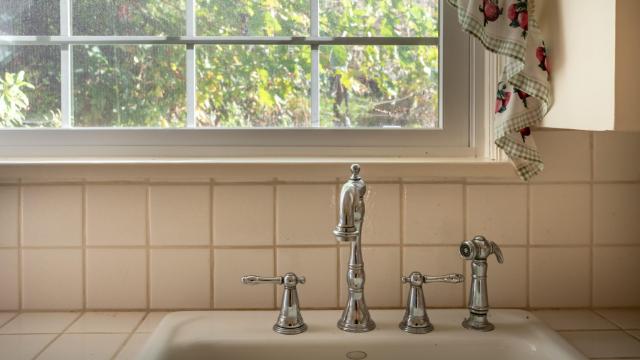Whether you have a slow leak or are just looking to spruce up your kitchen, updating your old tap can help conserve water and make your kitchen more efficient. Though handling the job yourself may seem intimidating, it’s totally doable, and it will pay dividends in the form of lower monthly bills and avoiding a potentially costly repair down the road. Here’s how to get started.
Gather your tools
As always, before you begin, make sure you have everything you need to get the job done — stretching this fix over two days because you forgot a crucial tool is going to be a headache.
First, the wrenches — you’ll need a crescent wrench as well as a tap wrench. And while not always necessary, a tap or basin wrench will make it much easier to reach the nuts that hold your tap together, and one usually costs about $US10 ($14), so worth considering. Plumber’s tape (also called thread seal) is another good item to have on hand; it will allow you to make the connections on your plumbing water-tight. You’ll also need a flashlight, as the space under your sink is undoubtedly dark and cramped. Being able to see will help you avoid a damp surprise.
Check for leaks
Start by checking for leaks. Turn on the existing tap to a low stream, and look under the sink to see if there is any moisture coming from the pipes down there. If there is, try tightening up the hardware that holds the hoses together. Place one wrench on one side of the connection point and one on the other. Turn the working wrench to the right. If doing this to all of the connections under the sink eliminates the leak, then you can move on.
Find your shutoff valves
If you encounter a more persistent leak (or if you want to replace rather than repair your tap), you’ll need to shut off the water before taking the next step. The shutoff valves are usually located under the sink, and are often oval in shape. There should be two — one for hot water and one for cold water — and they will most likely be located under the sink basin, against the wall. To stop the flow of water, turn the handles clockwise.
Inspect your hardware
Once the water is off, continue checking for leaks by undoing the hose connections from the tap and the shutoff valves. There should be some thread seal tape on these connections; if there isn’t, you can add some. Remove the old tape and look for any corroded or cracked washers. Inspect the hoses to determine if they’re in good shape. If you need to replace washers or hoses, new ones can be obtained from the plumbing section of any hardware store. If you’re unsure of what kind you need, bring your old parts with you to use for comparison.
Choose a tap
If your leak is coming from the top side of the sink, or if you just want newer hardware, you’ll need a new tap. Most taps come in standard sizes, so fitting them depends mostly on how many water lines you need. If there’s a spot for a separate sprayer nozzle or other accessory, you’ll need a faucet with three water lines. For other sink types, you can use just two. It’s a good idea to take a careful look at your old tap before shopping for a new one to make sure you get one that fits your sink. (Maybe bring a picture with you — it can be surprisingly hard to remember details when faced with dozens of shiny new options.)
Install your new parts
If you’re simply replacing washers and hoses, reinstall your new parts by using about three wraps of plumber’s tape at each connection and tightening the nuts.
If you’re also replacing the tap, you’ll need to remove the old one. On many kitchen sinks, this is where a basin wrench is handy, because the nuts holding the existing faucet onto the sink are behind the sink basin, under the counter between the basin and the wall, and good luck reaching them. Once those nuts are undone and the hoses are disconnected, the existing tap should simply lift out. Then, making sure to use thread seal tape wherever there’s a connection between hoses, you can attach the hoses to the new tap and thread them through the holes in your sink. This step will let you avoid having to tighten these connections in the tight quarters behind the basin.
Next, use the hardware that came with your new tap and your basin wrench to attach the new tap to the sink. Connect the new hoses to the water lines coming from the wall, using your plumber’s tape wherever two hoses are joined. Make sure all your hardware is tight, and then turn the water back on by turning the shutoff knobs counter-clockwise.
Double-check your hardware
Once the water is on, check for leaks again. If everything is dry, test your taps and check again. If you have a small amount of leakage, turn the water off and tighten all the hose connections again. You can also add some thread seal if the connection is a little loose. On new hardware, this should do the trick. Do a final check to make sure that everything is still dry. Congratulations! You just fixed your own sink.

Leave a Reply
You must be logged in to post a comment.